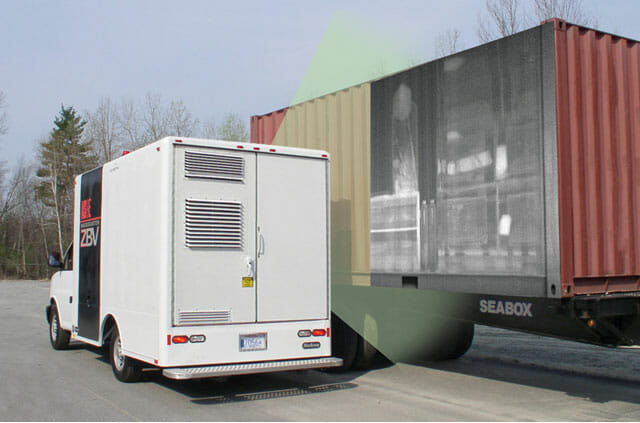
The manufacture of Lead sub-assemblies requires multiple lead manufacturing skills
Backscatter X-Rays
In a medical setting X-rays are traditionally used to produce an image by transmission. The X-rays pass through the body and denser parts such as bones absorb more of the radiation. This type of X-ray scan is not a good method of imaging organic matter such as flesh, drugs or explosive material.
Backscatter X-ray scanners, on the other hand, detect radiation that reflects from an object, the backscatter pattern is dependent on the material properties and the scanner can be used very successfully to image organic material. Today backscatter X-ray machines are increasingly being used both to scan passengers at airports and also to scan cargo containers and trucks at ports and to scan the insides of vehicles at the entrance to important locations.
This article describes the construction of one of the key components of the cargo and truck scanners the lead shielding assembly that provides the X-ray beam channel.
Using Backscatter scanning
Organic matter, such as explosive material and drugs, contains low atomic number elements such as carbon, oxygen, hydrogen, and nitrogen. These elements are much more visible on backscattered electron scanning than on traditional x-rays.
In order to create the image a sweeping beam of X-rays is scanned across the truck or cargo canister that is being examined. Then the intensity of the reflected X-rays is measured as a function of position. The resulting plot is a photo like rendition of the objects within the truck, with a particularly strong signal for explosives, plastics, and other biological items.
Radiation shielding Subassembly
One of the key elements in this system is the lead assembly that helps to direct the beam; this is a highly complex radiation shielding component that has very tight machining tolerances. It consists of several individual parts and requires several manufacturing disciplines. Nuclead is one of the few companies in the USA that can accomplish all of manufacturing tasks involved to the tolerances required.
The completed lead subassembly is a fan shaped structure, which has a top and a bottom that mate together to form a lead shielded slotted channel, in the middle of the unit, which directs the X-ray beam. The complete backscatter scanning machine consists of an array of several of these radiation shielding subassemblies.
The rest of this article offers descriptions of some of the processes required to create this subassembly.
Lead Machining
Lead plate is a difficult metal to machine due to its malleability; several of the components in this sub assembly require tolerances that are extremely tight.
Machined metal components are required to achieve tolerances of 50 millionths, or 1/100 of the diameter of a human hair.
Nuclead and Sharp manufacturing has the latest CAD-CAM software available and meet these tolerances using CNC in house machining capabilities, and can provide 3D computer models of the components for approval prior to manufacture.
Lead Lamination
Certain sections of the subassembly are required to be lined with lead sheeting, this is a process called lead lamination. The lead is attached or laminated using a pressure sensitive adhesive, which requires no solvent, water or heat in order make the bond, only the pressure applied determines the strength of the bond.
The thickness of lead sheet required is dependent on the peak voltages generated by the X-ray coil. For example X-rays generated with a peak voltage of 200kv requires a minimum thickness of 4 mm.
Lead welding
Very few manufacturers have the skills required to successfully weld lead. Lead is a very soft metal and can easily deform under its own weight unless supported by a stronger metal such as steel. Lead is always welded with a gas flame, either the oxy-acetylene flame or another oxy-fuel gas flame.
The lead welding operation is sometimes, erroneously, referred to as” lead burning” though no actual combustion is involved.
Metal stamping, sawing and bending
Various mechanical operations are required to fabricate the radiation scanning subassembly, among these are stamping, sawing and bending.Stamping is available on up to 1/8” thick stock with a capacity of 1/8” x 36” (l x w).
Nuclead can saw water-jet or CNC machine larger and thicker sizes as needed to tolerances of 50 millionths.
Finishing and painting
The completed subassembly is finished and painted using eggshell black paint.
Conclusion
Backscatter X-ray scanners are increasingly finding use in security applications, because backscatter X-rays unlike traditional X-rays are able to image organic material such as hidden people, drugs and explosives. Back scanning X-ray machines are being deployed at airports and points of entry to the USA, to allow for the scanning of cargo containers and trucks. A key component of the machine is a the lead shielding subassembly, a complex unit that requires skills and expertise across a wide range of disciplines including lead and other metal machining to close tolerances, lead welding and lead Lamination with lead sheet.
Nuclead is one of the few manufacturers have all of these disciplines in house.